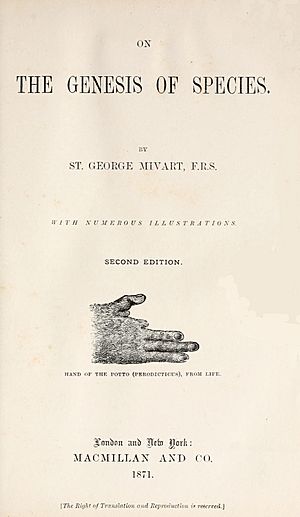St. George Jackson Mivart facts for kids
Quick facts for kids
St. George Jackson Mivart
|
|
|---|---|

Mivart, by Barraud & Jerrard
|
|
| Born | 30 November 1827 London, England
|
| Died | 1 April 1900 (aged 72) London, England
|
St. George Jackson Mivart FRS (30 November 1827 – 1 April 1900) was an English biologist. He is famous for starting as an ardent believer in natural selection and later becoming one of its fiercest critics. Mivart attempted to reconcile the theory of evolution as propounded by Charles Darwin with the beliefs of the Catholic Church but was condemned by both Darwin and the Church. His belief in a soul created by God and insistence that evolutionism was not incompatible with the existence of such a God brought him into conflict with other evolutionists, while his theological theories on hell and on the compatibility between science and Catholicism led him to clash with the Church.
Contents
Early life
Mivart was born in London. His parents were Evangelicals, and his father was the wealthy owner of Mivart's Hotel (now Claridge's). His education started at the Clapham Grammar School, and continued at Harrow School and King's College London. Following his conversion to Catholicism, he was instructed at St. Mary's, Oscott (1844–1846), and was confirmed there on 11 May 1845. His conversion automatically excluded him from the University of Oxford, then open only to members of the Anglican faith. His mother followed him into the Catholic Church in 1846.
Appointments
In 1851 he was called to the bar at Lincoln's Inn, but he devoted himself to medical and biological studies. In 1862 he was appointed to the chair in zoology at St. Mary's Hospital medical school. In 1869 he became a fellow of the Zoological Society of London, and in 1874 he was appointed by Mgr Capel as Professor of Biology at the short-lived Catholic University College, Kensington, a post he held until 1877.
He was vice-president of the Zoological Society twice (1869 and 1882); Fellow of the Linnean Society from 1862, secretary from 1874 to 1880, and vice-president in 1892. In 1867 he was elected a Fellow of the Royal Society for his work "On the Appendicular skeleton of the Primates". This work was communicated to the society by Thomas Henry Huxley. Mivart was a member of the Metaphysical Society from 1874. He received the degrees of Doctor of Philosophy from Pope Pius IX in 1876, and of Doctor of Medicine from the University of Louvain in 1884.
Death
Mivart died of diabetes in London on 1 April 1900. His late heterodox opinions were a bar to his burial in consecrated ground. However, Sir William Broadbent gave medical testimony that these could be explained by the gravity and nature of the diabetes from which he had suffered.
After his death, a long final struggle took place between his friends and the church authorities. On 6 April 1900, his remains were deposited in catacomb Z beneath the Dissenters' Chapel, in the unconsecrated ground of the dissenters' section of the General Cemetery of All Souls, Kensal Green, in a public vault reserved for 'temporary deposits' (most of which were destined for repatriation to mainland Europe or the Americas). His remains were finally transferred to St. Mary's Roman Catholic Cemetery, Kensal Green, on 16 January 1904, for burial there on 18 January 1904.
Legacy
Mivart's name is commemorated in the scientific name of a species of lizard, Emoia mivarti.
Other sources


